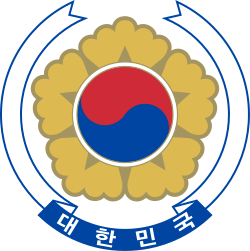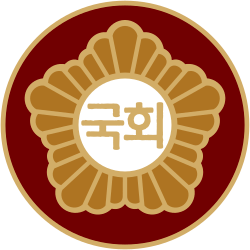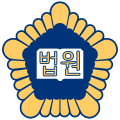Constitution of South Korea
 |
|---|
| This article is part of a series on the politics and government of the Republic of Korea |
| Constitution |
|
Judiciary |
The Constitution of the Republic of Korea (Hangul: 대한민국 헌법; Hanja: 大韓民國憲法) is the basic law of South Korea. It was promulgated on July 17, 1948, and was last revised on October 29, 1987.
History
South Korea's first 1948 Constitution, drafted by Dr. Chin-O Yu (Hangul: 유진오; Hanja 兪鎭午), framed a presidential system mixed with a parliamentary system. It gave the president to act as the head of state, be elected directly by the National Assembly, and share executive power with the cabinet.[1] The Constitutional Charter of the Provisional Government of the Republic of Korea of 1919 became the forerunner of 1948 Constitution.[2]
The 1949 Constitution has first amended in 1952 ahead of Syngman Rhee's re-election, providing for direct presidential elections and a bicameral legislature. It was passed with procedural irregularities after fierce debate. In 1954, Rhee again forced an amendment, removing term limits for himself and emphasizing a capitalistic economic model.
Rhee was overthrown in 1960 following widespread protests against his increasingly authoritarian rule. Partly in response to Rhee's abuses, the Second Republic turned to a parliamentary system. The 1960 Constitution provided for a figurehead president, a bicameral legislature, a cabinet headed by a prime minister, an election commission, and a constitutional commission. It also provided for elections for supreme court justices and provincial governors, as well as natural law-based individual rights.
With the May 16 coup of Park Chung-hee in 1961, the 1960 version was nullified, and in 1962, the Third Republic's Constitution was passed. This document returned to a presidential system. It had a number of similarities to the United States Constitution, such as nominal judicial review functions. In 1972, Park extended his rule with the Fourth Republic constitution, called the Yusin Constitution, which gave the president sweeping (almost dictatorial) powers and permitted him to run for an unlimited number of six-year terms.
After Park was assassinated in 1979, the Fifth Republic began with the 1980 Constitution under President Chun Doo-hwan. The president's powers were curbed somewhat, and he was barred from reelection after his seven-year term. It also provided for a unicameral legislature and a cabinet system.
With the pro-democratic protests of 1987 (June Democracy Movement), the 1988 Constitution of the Sixth Republic was passed. The constitutional bill was passed by the National Assembly on October 12, 1987, and approved by 93 percent in a national referendum on October 28, taking effect on February 25, 1988, when Roh Tae-Woo was inaugurated as president.
Amendment of the Constitution of South Korea[3]
| amendment | date | amendment range | president |
|---|---|---|---|
| 1st | 1948.7.17 | established | Syngman Rhee |
| 2nd | 1952.7.7 | partly | Syngman Rhee |
| 3rd | 1954.11.29 | partly | Syngman Rhee |
| 4th | 1960.6.15 | partly | Syngman Rhee |
| 5th | 1960.11.29 | partly | Yun Posun |
| 6th | 1962.12.26 | whole | Park Chung-hee |
| 7th | 1969.10.21 | partly | Park Chung-hee |
| 8th | 1972.12.27 | whole | Park Chung-hee |
| 9th | 1980.10.27 | whole | Chun Doo-hwan |
| 10th | 1987.10.29 | whole | Chun Doo-hwan |
Succession of spirit
- the preamble to the Constitution of South Korea[4]
Spirit of 4. 19 revolution
The spirit of April nineteenth and March 1st movement is stipulated in the preamble of Constitution of South Korea. But it took a long time to be established. The contents of the April revolution were removed on the fifth amendment, and these were included in the preamble on the sixth amendment, identified with May 16 coup. After the ninth amendment, the spirit of the April revolution was excepted from the preamble, and it was included for the ‘Resistance ideology for protection of democratic constitution’ on the 10th amendment.[5]
Spirit of Provisional Charter of Korea
The Provisional Charter of Korea is the first constitution of Korean Provisional Government, which was promulgated in 1919. It made the name of the country as ‘Republic of Korea’, and it is made up of the preamble of 10 articles. The provisional charter of Korea became the primary spirit of current Constitution, which is stipulated in the preamble of Constitution of South Korea.[6]
Provisional Charter of Korea[7]
- The Republic of Korea is a democratic republic country.
- The Republic of Korea should be governed by the provisional people of the provisional government.
- All citizens of the Republic of Korea are equal without gender, wealth and stratum.
- All citizens of the Republic of Korea have the rights to be free of religion, media, writing, publishing, association, assembly, the charge of address, body and ownership.
- The citizens who have the qualification of the citizen of the Republic of Korea have a right to vote and to be elected.
- The citizens of the Republic of Korea have a duty to education, taxation, and military service.
- The Republic of Korea will join the League of Nations in order to exert its founding spirit in the world and to contribute to human culture and peace by the will of the citizens.
- The Republic of Korea gives preference to the old imperial family.
- The Republic of Korea forbids the punishment of life, body, and licensed prostitution.
- The Provisional Government convenes the National Assembly within one year after the restoration of the country.
Structure
Consisting of a preamble, 130 articles, and supplementary provisions, the Constitution provides for an executive branch headed by a president and an appointed prime minister, a unicameral legislature called the National Assembly, and a judiciary consisting of the Constitutional Court, Supreme Court and lower courts.
The President is elected by a First Past the Post vote and limited to a single five-year term. The Prime Minister is appointed by the President with the consent of the National Assembly. Although not required by the Constitution, the President also appoints members of the cabinet. President Kim Dae-jung changed to the cabinet system.
The National Assembly consists of at least 200 (presently 300) members elected to four-year terms. The Supreme Court's chief justice is appointed by the president and up to 13 other justices appointed by the president on the recommendation of the chief justice with the approval of the National Assembly. The President serves a six-year term.
The Constitution declares South Korea a "democratic republic" (taken from Article 1 of Constitutional Charter of the Provisional Government of the Republic of Korea of 1919),[2] its territory consisting of "the Korean Peninsula and its adjacent islands," and that "The Republic of Korea shall seek unification and shall formulate and carry out a policy of peaceful unification based on the principles of freedom and democracy." There are disputes over what "freedom and democracy" mean in Korea, but the direct translation of the Korean word used in the constitution (자유민주적 기본질서) would be liberal democracy.
Individual rights
South Korean Bill of Rights (or fundamental right) is Constitution CHAPTER 2. RIGHTS AND DUTIES OF CITIZENS (4-687) Individuals may not be punished, placed under preventive restrictions, or subjected to involuntary labor except as provided by law. Those detained or arrested must be informed of the reason and of their right to an attorney, and family members must be informed. Warrants must be issued by a judge "through due procedures," and accused persons may sue for wrongful arrest in certain cases.
However, individual rights are qualified by other constitutional provisions and pre-existing laws, including the National Security Act, which restricts due process rights.
Economic provisions
In Article 119, stable and balanced growth rates, "proper distribution of income", and preventing "abuse of economic power" are explicitly listed as goals of the government. The regulatory goal to "democratize the economy through harmony among economic agents" in the same article reflects the strong prevalence of traditional Korean values and the close relationship between politics and the economy. Article 125 designates foreign trade as a strategic area to be fostered, regulated and coordinated by the government.
The Constitution affirms both the right and the duty to work, requiring regulation of minimum wages and working conditions. Workers have the right to independent association, collective bargaining, and collective action.
Political neutrality
Political neutrality is a constitutional convention which provides that public servants should avoid activities likely to impair, or seem to impair, their political impartiality or the political impartiality of the public service.[8] The political neutrality of South Korea's Constitution is guaranteed in the area of military, administration, and education. In the form of the guarantee of 'political neutrality', the constitution provides an objective legal system to guarantee political neutrality as an essential element of the system, unlike the form of guarantee of basic rights.[9]
Military
Article 5 (2) of the Constitution stipulates that "the ROK military shall fulfill the sacred duty of national security and defense of the nation, and its political neutrality shall be obeyed" .
Education
Education promotes the potential of individuals so that individuals can develop their personality in each area of life. In view of the important functions of education, Article 31(6) of the Constitution stipulates to specify in the law about the basic laws and regulations about the education system and its operation, education finances and the status of teachers.
Administration
Political neutrality of public officials is specified in the law. Article 6(2) of the Constitution stipulates that "The status and political neutrality of public officials shall be guaranteed by law". Also, Article 9(1) of the Public Service Elections act regulates that Public servants or any other person (including any organization or organization) that is required to be in a political neutrality shall not engage in any unfair influence on the election or otherwise act on the election results. Article 65 of the Public Officials Act(Prohibition of Political Movement) Section 2 regulates that Public officials shall not engage in the following activities to support or oppose a specific political party or a particular person in an election.
1. To make an invitation to vote or not
2. Pray, preside, or recommend the signatory movement.
3. To publish or post documents or books to public facilities
4. To make a donation recruitment, or to use public funds
5. To encourage others to join or not to join a political party or other political organizations
Differences with other constitutions
U.S.
The difference between the constitutions of South Korea and the U.S. is shown in many constitution provisions. For example, Article 66 to 85 in the constitution of South Korea prescribes the law about the president. The constitution of the U.S. prescribes the law about the president in Article Two. In South Korea, the president is voted by Direct election. He or she serves a single five-year term, and no additional terms are allowed. His or her major roles include (1) Head of State, (2) Chief administrator, (3) Commander-in-chief, (4) Top diplomat and foreign policy maker (5) Chief policy maker and key lawmaker. The Prime Minister is the replacement in the event of presidential disability. However, in the US, the president is elected by indirect election. He or she can serve for 10 years (Only if the president dies and Vice President becomes presidents for 4 years and gets reelected). The president can get reelected by running a presidential campaign again after 4 years of running president. His or her major roles include (1) Head of State, (2) Chief administrator, (3) Commander-in-chief, (4) Veto or Agree on Bill Separation of Powers Legislative Branch Facts. The Vice president is the replacement in the event of presidential disability.
Constitutional Court
Following the 1987 revision, the Constitutional Court was established in September 1988. Based on the European model, it is a specialized court that determines the Constitutionality of laws, disputes between governmental entities, Constitutional complaints filed by individuals, impeachments, and dissolution of political parties. Earlier constitutions provided for various forms of judicial review, but the judiciary did not exercise actual independence.
The Court's nine Justices serve six-year renewable terms. As of December 2004, the Court has declared 418 laws unconstitutional and revoked about 214 governmental actions.
Related Articles Of the Constitution Court[10]
Articles 111 through 113 of the Constitution of the Republic of Korea refer to the Constitutional Court.
Article 111
Article 111 of the Constitution stipulates the enforcement of the Constitutional Court and the qualifications and appointments of the Constitutional Court Judges.
Article 111 (1)
Section 1 sets out five judgments ruled by the Constitutional Court.
- The constitutionality of a law upon the request of the courts: Judge whether the law enacted by the National Assembly violates the Constitution.
- Impeachment referee: If a public official in a high position, such as the president, violates the Constitution and the law, he may withdraw from office.
- Political party dissolution: A political party that violates the purpose or basic order of a political party can dissolve the political party.
- Competence disputes between State agencies, between State agencies and local governments, and between local governments: It plays a role of solving the case of disputes between national institutions, national institutions, local autonomous bodies, and local autonomous entities.
- Constitutional appeal: Judgment of the constitutional wishes such as whether the state violates the rights of the people.
Paragraphs 2 to 4 refer to the judges of the Constitutional Court.
Article 111 (2)
Paragraph 2 states that the judge of the Constitutional Court is qualified as a judge and that a total of nine persons are appointed by the President.
Article 111 (3)
In paragraph 3, three of the judges of the Constitutional Court shall be selected by the National Assembly, and the three shall be appointed by the Chief Justice of the Supreme Court. This means the division of three government powers between the executive, judicial and legislative branches.
Article 111 (4)
The President of the Republic, with the consent of the National Assembly, appoints the President of the Constitutional Court as the Constitutional Court judge.
Article 112
Article 112 of the Constitution stipulates the term of the members of the Constitutional Court, its limitations, and the things to be observed.
Article 112 (1)
Clause 1 states the term of the judge of the Constitutional Court. The term of the members of the Constitutional Court is six years and it is stipulated that it can be renewed by the law.
Article 112 (2)
Section 2 specifies what the judges of the Constitutional Court must observe. The judges of the Constitutional Court declare that they can not join political parties and can not engage in politics.
Article 112 (3)
Section 3 sets out the terms and conditions of the Constitutional Court's jurisdiction. The judges of the Constitutional Court declare that they are not excluded unless they are impeached or sentenced to a sentence of more than an imprisonment without prison labor.
Article 113
Article 113 of the Constitution specifies the powers of the Constitutional Court.
Article 113 (1)
Paragraph 1 stipulates the judgment of the Constitutional Court. It is stipulated that there should be more than 6 judges in case of the unconstitutional decision of law, the decision of impeachment, the decision of dissolution of the political party, or constitutional appeal decision.
Article 113 (2)
Paragraph 2 of the Constitution provides for the rule-making powers of the Constitutional Court. The Constitutional Court may establish rules on judicial procedures, internal discipline, and administrative proceedings, as long as they do not conflict with the law.
Article 113 (3)
Paragraph 3 stipulates that the law requires the organization and operation of the Constitutional Court and other necessary matters. This law is the Constitutional Court Act.[11]
Case of the Constitution Judgement
Case number[12]
The case administered by the Constitutional Court has a case number in the form of <year classification - case code - progress number>. For example, the case number of the case of “Case on Defamation against the President” whose decision date is 26 December 2013. is “2009Hun-Ma747”.[13]
Year classification
It is the year of the day the case was billed. Before 2000, only two digits after the year, and four digits after the year.
Case code
It is the classification of the case which is the case goes into. It is made up of two letters, the first letter is 'Hun'. This represents the Constitutional Court is responsible for this case. The second letter consists of 'Ka' to 'A'(Ka, Na, Da, Ra, Ma, Ba, Sa, A). In the case of the Constitutional Court, there shall be ‘Ka’ to ‘Ba’ in the order of Article 111, Paragraph 1 of the Constitution of the Republic of Korea. In other words, if the case of the judgement of the unconstitutional law by the court's request, 'Ka' is assigned, 'Na' is the judgement of the case of the impeachment judgment, 'Da' is the judgment of the case of the dissolution of the political party, and ‘Ra’ is the judgement of the case of Competence disputes between State agencies, between State agencies and local governments, and between local governments. The Constitutional Appeal under Article 68 (1) of the law of Constitutional Court Act is ‘Ma’ and under Article 68 (2) of the law of Constitutional Court Act is ‘Ba’. In addition, various application cases are 'Sa' and various special cases are accompanied by 'A'.
Progress number
Progress numbers should be serialized in the order of time of receiving bill during the year.
Case Statistics[14]
This is the constitutional case aggregate table until 31 October 2017.
| Type | Total | Constitu-tionality of Statutes1) | Impeach-ment | Dissolution of a Polit-ical Party | Compe-tence Dispute | Constitutional Complaint | |||
|---|---|---|---|---|---|---|---|---|---|
| Sub total | §68 I | §68 II | |||||||
| Filed | 32,844 | 935 | 2 | 2 | 102 | 31,803 | 25,443 | 6,360 | |
| Settled | 31,953 | 879 | 2 | 2 | 88 | 30,982 | 24,936 | 6,046 | |
| Dismissed by Panel | 17,929 | 17,929 | 14,737 | 3,192 | |||||
| Decided by
Full Bench |
Unconstitutional2 | 580 | 274 | 306 | 104 | 202 | |||
| Unconformable3) | 189 | 59 | 130 | 59 | 71 | ||||
| Conditionally
Unconstitutional4) |
70 | 18 | 52 | 20 | 32 | ||||
| Conditionally
Constitutional5) |
28 | 7 | 21 | 21 | |||||
| Constitutional | 2,410 | 329 | 2,081 | 4 | 2,077 | ||||
| Upholding6) | 635 | 1 | 1 | 17 | 616 | 616 | |||
| Rejected | 7,254 | 1 | 20 | 7,233 | 7,233 | ||||
| Dismissed | 1,948 | 69 | 1 | 35 | 1,843 | 1,512 | 331 | ||
| Other | 10 | 10 | 8 | 2 | |||||
| Withdrawn | 900 | 123 | 16 | 761 | 643 | 118 | |||
| Pending | 891 | 56 | 14 | 821 | 507 | 314 | |||
Footnotes of table
1. This type of "Constitutionality of Statutes" case refers to the constitutionality of statutes cases brought by ordinary courts, i.e., any court other than the Constitutional Court.
2. "Unconstitutional": Used in Constitutionality of Laws cases.
3. "Unconformable": This conclusion means the Court acknowledges a law's unconstitutionality but merely requests the National Assembly to revise it by a certain period while having the law remain effective until that time.
4. "Conditionally Unconstitutional": In cases challenging the constitutionality of a law, the Court prohibits a particular way of interpretation of a law as unconstitutional, while having other interpretations remain constitutional.
5. "Conditionally Constitutional": This means that a law is constitutional if it is interpreted according to the designated way.This is the converse of "Unconstitutional, in a certain context". Both are regarded as decisions of "partially unconstitutional".
6. "Upholding": This conclusion is used when the Court accepts a Constitutional Complaint which does not include a constitutionality of law issue.
See also
References
- ↑ Public Administration and Policy in Korea: Its Evolution and Challenges edited by Keun Namkoong
- 1 2 Republicanism in Northeast Asia edited by Jun-Hyeok Kwak, Leigh Jenco
- ↑ "National Law Information Center_Constitution of South Korea". Archived from the original on 2015-09-28.
- ↑ "National Law Information Center". Archived from the original on 2016-04-01.
- ↑ The History of Korean Constitution in terms of its Spirit: A Study on the Introduction of the April 19 Uprising into the Preamble to the Constitution edited by Hee Kyung Suh
- ↑ Reexamining Political Participation in Rousseau’s Political Thought: Does Citizens’Political Participation Include Public Discussions and Debates edited by KANG Jung In
- ↑ 한국근현대사사전. 가람기획: 한국사사전편찬회. 2005. ISBN 978-8984351936.
- ↑ Sossin, Lorne (2006-02-01). "Defining Boundaries: The Constitutional Argument for Bureaucratic Independence and its Implication for the Accountability of the Public Service". Rochester, NY.
- ↑ 류, 시조 (February 2015). "한국 헌법상의 정치적 중립성에 관한 연구". 공법학연구 제 16권 제 1호: 49–70.
- ↑ 국가법령정보센터. "대한민국헌법". law.go.kr (in Korean). Archived from the original on 2014-05-08. Retrieved 2017-11-30.
- ↑ 국가법령정보센터. "헌법재판소법". law.go.kr (in Korean). Archived from the original on 2017-12-01. Retrieved 2017-11-30.
- ↑ 국가법령정보센터. "헌법재판소 사건의 접수에 관한 규칙". law.go.kr (in Korean). Archived from the original on 2017-12-01. Retrieved 2017-11-30.
- ↑ "전자헌법재판센터". www.ccourt.go.kr (in Korean). Archived from the original on 2017-12-01. Retrieved 2017-11-30.
- ↑ 헌법재판소. "Constitutional Court Korea > > Decisions > Stastics". english.ccourt.go.kr (in Korean). Retrieved 2017-11-30.
External links
| Wikisource has original text related to this article: |
- Constitution of the Republic of Korea | National Assembly of the Republic of Korea | English; html, Word, PDF
- Constitution of South Korea | Wikisource | English; html
- Korea Britannica article through Daum.net, in Korean
- Jisik Q&A at Yahoo Korea, in Korean
- Institut für öffentliches Recht, in English, with timeline
- U.S. Department of State
- Constitutional Court of Korea
- U.S. Library of Congress - Country Studies


